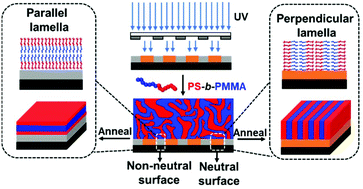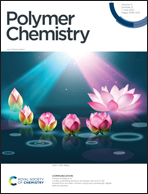Photo-directing chemoepitaxy: the versatility of poly(aryl methacrylate) films in tuning block copolymer wetting†
Abstract
Photo-directed orientation control of block copolymer (BCP) domains is a powerful method for generating distinct regions of perpendicular and parallel-aligned lamella in a single film layer. In this study we demonstrate the versatility of aromatic methacrylate polymer films for tuning the wetting behaviour of PS-b-PMMA films on UV exposure. Poly(aryl methacrylate) films with excellent thermal and solvent stability were obtained by thermal crosslinking of spin-coated films. Upon exposure to UV light (254 nm), the surface polarity of the films changed as a result of the photo-Fries rearrangement of the aromatic ester groups. Following UV exposure to appropriate doses, the irradiated poly(aryl methacrylate) films can induce a change in the orientation of the domains of an overlayer of PS-b-PMMA from parallel to perpendicular lamellar structures. Patterning with a photomask enables generation of high fidelity BCP microdomain regions with targeted orientation. It is worth noting that the UV dose required to induce lamellar orientation in a wide range of BCP films can be tailored by rational selection of the poly(aryl methacrylate), suggesting outstanding flexibility in controlling BCP wetting behaviour. This simple, rapid, cost-effective and flexible approach to controlling BCP orientation makes poly(aryl methacrylate)s extremely promising for block copolymer self-assembly applications.



 Please wait while we load your content...
Please wait while we load your content...